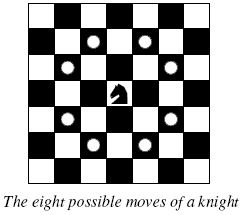这道题的题意是:
 Background
Background
The knight is getting bored of seeing the same black and white squares again and again and has decided to make a journey
around the world. Whenever a knight moves, it is two squares in one direction and one square perpendicular to this. The world of a knight is the chessboard he is living on. Our knight lives on a chessboard that has a smaller area than a regular 8 * 8 board, but it is still rectangular. Can you help this adventurous knight to make travel plans?
Problem
Find a path such that the knight visits every square once. The knight can start and end on any square of the board.
给出一个国际棋盘的大小,判断马能否不重复的走过所有格,并记录下其中按字典序排列的第一种路径。经典的“骑士游历”问题、
主要得注意一下需要输入出字典序最小的一种路,所以在dfs的时候要先从第一个点开始,还有就是注意遍历的顺序
字典序小的先遍历 、、
A Knight's Journey
| Time Limit: 1000MS | Memory Limit: 65536K | |
| Total Submissions: 25999 | Accepted: 8869 |
Description
 Background
Background
The knight is getting bored of seeing the same black and white squares again and again and has decided to make a journey
around the world. Whenever a knight moves, it is two squares in one direction and one square perpendicular to this. The world of a knight is the chessboard he is living on. Our knight lives on a chessboard that has a smaller area than a regular 8 * 8 board, but it is still rectangular. Can you help this adventurous knight to make travel plans?
Problem
Find a path such that the knight visits every square once. The knight can start and end on any square of the board.
Input
The input begins with a positive integer n in the first line. The following lines contain n test cases. Each test case consists of a single line with two positive integers p and q, such that 1 <= p * q <= 26. This represents a p * q chessboard, where p describes how many different square numbers 1, . . . , p exist, q describes how many different square letters exist. These are the first q letters of the Latin alphabet: A, . . .
Output
The output for every scenario begins with a line containing "Scenario #i:", where i is the number of the scenario starting at 1. Then print a single line containing the lexicographically first path that visits all squares of the chessboard with knight moves followed by an empty line. The path should be given on a single line by concatenating the names of the visited squares. Each square name consists of a capital letter followed by a number.
If no such path exist, you should output impossible on a single line.
If no such path exist, you should output impossible on a single line.
Sample Input
3 1 1 2 3 4 3
Sample Output
Scenario #1: A1 Scenario #2: impossible Scenario #3: A1B3C1A2B4C2A3B1C3A4B2C4
#include <stdio.h>
#include <string.h>
#include <iostream>
#include <stdlib.h>
using namespace std;
struct node
{
int id;
char s;
} f[1011];
int p, q, x, y;
int map[101][101];
void find(int i, int j, int num)
{
switch(num)
{
case 1: {x=i-1; y=j-2; break;}
case 2: {x=i+1; y=j-2; break;}
case 3: {x=i-2; y=j-1; break;}
case 4: {x=i+2; y=j-1; break;}
case 5: {x=i-2; y=j+1; break;}
case 6: {x=i+2; y=j+1; break;}
case 7: {x=i-1; y=j+2; break;}
case 8: {x=i+1; y=j+2; break;}
}
}
int dfs(int i, int j, int step)
{
map[i][j] = 1;
f[step].id = i;
f[step].s = j;
if(step == f[0].id)
return 1;
for(int k = 1; k <= 8; k++)
{
find(i, j, k);
int ii = x, jj = y;
if(!map[ii][jj] && ii >= 1 && ii <= p && jj >= 'A' && jj <= 'A'+q-1)
if(dfs(ii, jj, step+1))
return 1;
}
map[i][j] = 0;
return 0;
}
int main()
{
int T, t = 1, i, j;
scanf("%d",&T);
while(T--)
{
memset(map , 0 , sizeof(map));
scanf("%d %d",&p,&q);
f[0].id = p*q;
int flag = 0;
for(j = 'A'; j <= 'A'+q-1; j++)
{
for(i = 1; i <= p; i++)
if(dfs(i , j , 1))
{
flag = 1;
printf("Scenario #%d:\n",t++);
for(int k = 1; k <= f[0].id; k++)
printf("%c%d",f[k].s, f[k].id);
printf("\n\n");
break;
}
if(flag)
break;
}
if(!flag)
printf("Scenario #%d:\nimpossible\n\n",t++);
}
return 0;
}
























 838
838











 被折叠的 条评论
为什么被折叠?
被折叠的 条评论
为什么被折叠?








